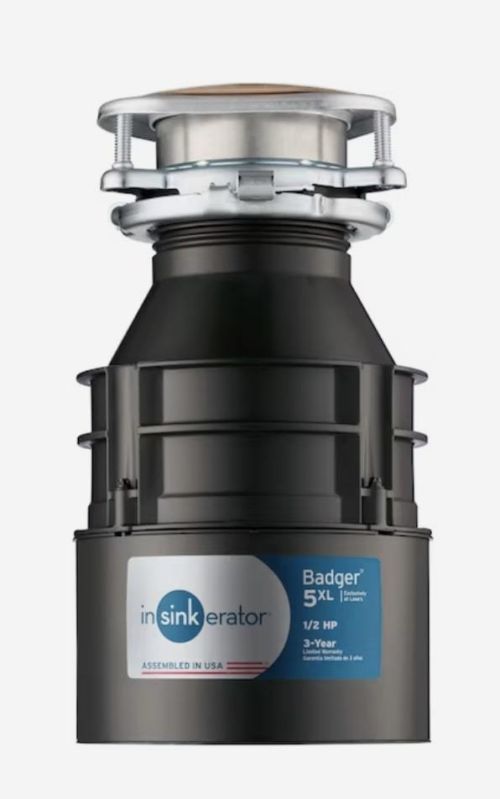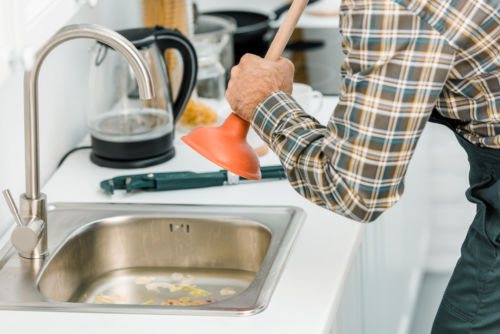How to Clean and Unclog a Garbage Disposal
November 10, 2023
One of the most common problems with garbage disposals is clogging. If your disposal is clogged, you might find yourself with a sink that drains slowly or not at all, and you may even experience foul odors. The good news is that cleaning and unclogging a garbage disposal can be a straightforward process when you know what to do.
In this guide, we'll walk you through the steps to keep your garbage disposal in top working condition.
- Understanding your garbage disposal
- Basic maintenance to prevent clogs
- Unclogging your garbage disposal
- Preventing future clogs
Don't let a clogged garbage disposal disrupt your daily routine. Contact Patrick Riley | Isley’s today!
Our skilled plumbers are equipped with the knowledge and tools to tackle even the toughest clogs in your garbage disposal. Plus, we back up every job with a 100% satisfaction guarantee. You can rest assured that we’ll get your clog fixed — no matter what. Schedule your clog cleaning service and enjoy a hassle-free kitchen once again!
See all kitchen plumbing services >>
Understanding Your Garbage Disposal

Before you dive into cleaning and unclogging, it's essential to understand how your garbage disposal works. A garbage disposal unit is typically mounted beneath your kitchen sink and connected to the drain. It consists of a grinding chamber, a motor, and a flywheel. When you turn on the disposal, the motor spins the flywheel, and the flywheel's blades break down food waste into tiny particles. These particles then flow through the plumbing system and into the sewer or septic tank.
Safety First
Before you start working on your garbage disposal, remember to prioritize safety. Here are a few safety tips to keep in mind:
- Turn off the power: For your safety, always turn off the power to the disposal unit. You can usually do this by unplugging it from the electrical outlet or switching off the circuit breaker.
- Avoid putting your hand down the disposal: Never insert your hand or any other foreign objects into the garbage disposal. Even when it's turned off, there might still be sharp components.
- Use appropriate tools: When working on your disposal, use the right tools for the job. This may include a flashlight, pliers, a wrench, and a hex key (Allen wrench).
- Disconnect from the sink: To prevent accidents, disconnect the disposal unit from the sink by loosening the mounting bracket before starting any work.
Basic Maintenance to Prevent Clogs
Regular maintenance can help prevent clogs from occurring in the first place. Here are some simple tips to keep your garbage disposal running smoothly:
Run Cold Water
Always run cold water when using the disposal and for a few seconds afterward. This helps carry food particles through the pipes and prevents them from sticking to the sides.
Use Cold Water with Soap
To clean the disposal and keep it smelling fresh, run cold water and add a little dish soap while the disposal is running. This will help remove grease and residue.

Avoid Hard or Fibrous Materials
Don't put hard materials like bones, shells, or coffee grounds down the disposal. Avoid fibrous materials like celery, corn husks, and potato peels, as they can tangle and clog the blades. Instead, consider composting or simply throwing it in the trash.
Small Food Portions
Feed small portions of food into the disposal to prevent overloading it. Let the unit finish processing one batch before adding more.
Unclogging Your Garbage Disposal

Despite your best efforts, clogs can still happen. Here's a step-by-step guide on how to clean and unclog your garbage disposal:
- Turn off the power: Ensure the disposal is completely disconnected from the electrical source. Safety should always be your top priority.
- Identify the cause of the clog: To tackle the clog effectively, you need to know what's causing it. Is it a foreign object or a buildup of food particles? Use a flashlight to inspect the inside of the disposal.
- Use pliers or tongs: If you can see and reach the clog, carefully use pliers or long tongs to remove the obstruction. Always use tools, not your hands, for safety reasons.
- Use a hex key: Many garbage disposals come with a special hex key (Allen wrench) that fits into a hole on the bottom of the unit. Insert the hex key and turn it back and forth to manually rotate the flywheel. This can help dislodge the clog.
- Use a plunger: If the clog persists, you can try using a sink plunger. Fill the sink with enough water to cover the rubber part of the plunger, create a seal, and give it a few good plunges. The pressure can sometimes dislodge the clog.
Chemical Cleaners
In some cases, you can use chemical cleaners specifically designed for garbage disposals. Follow the manufacturer's instructions carefully. These cleaners can help break down and dissolve clogs caused by grease and food residue.
Natural Cleaners
For minor clogs, use the classic DIY method of combining half a cup of baking soda and a cup of white vinegar, followed by cold water and activating the disposal. Additionally, maintain your disposal by dropping ice cubes and a couple of tablespoons of salt to clean the blades and grinding citrus peels (lemon, lime, or orange) to refresh the scent and cut through grease.
Preventing Future Clogs
Once you've successfully cleared a clog, it's essential to take steps to prevent future clogs. Here are some tips to keep your garbage disposal running smoothly:
- Keep running water: Always run cold water before, during, and after using the disposal to flush out food particles.
- Use it regularly: Regular use can help prevent rust and corrosion. Turn it on and grind some small food scraps, even if you don't have much waste to dispose of.
- Avoid overloading: Feed small portions into the disposal rather than trying to process a large quantity of food all at once.
- Clean it regularly: As mentioned earlier, use cold water and dish soap to clean the disposal. Grinding ice cubes and citrus peels can help maintain its freshness.
A well-maintained garbage disposal is an essential part of any functional kitchen. By following the steps outlined in this guide, you can ensure your disposal remains clog-free and operates at its best. Remember to prioritize safety at all times, and don't hesitate to seek professional help if you're unable to clear a stubborn clog. With the right care, your garbage disposal can continue to make meal cleanup a breeze for years to come.
Need help with your garbage disposal ASAP? Call Patrick Riley | Isley’s for reliable, same-day service!
We know that emergencies don't wait, and neither should you. Our team of expert plumbers is ready the very same day you call us. No more waiting around with a smelly and malfunctioning garbage disposal – we're here to help right when you need us. For flexible scheduling, honest pricing, and a guarantee of 100% satisfaction, call Patrick Riley | Isley’s today.
See all kitchen plumbing services >>
Get 10% off (Up to $150)

Ty Lindsay is the Director of Field Operations at Patrick Riley | Isley’s and a 15-year veteran of the plumbing and HVAC trades. In 2010, Ty earned his Journeyman’s plumbing license. He became a Master Plumber five years later and earned his Journeyman HVAC technician’s license that same year. Ty’s breadth of knowledge in plumbing and HVAC includes both residential and commercial work. He’s been a loyal member of the Patrick Riley | Isley’s team since 2016.
- Posted in:
